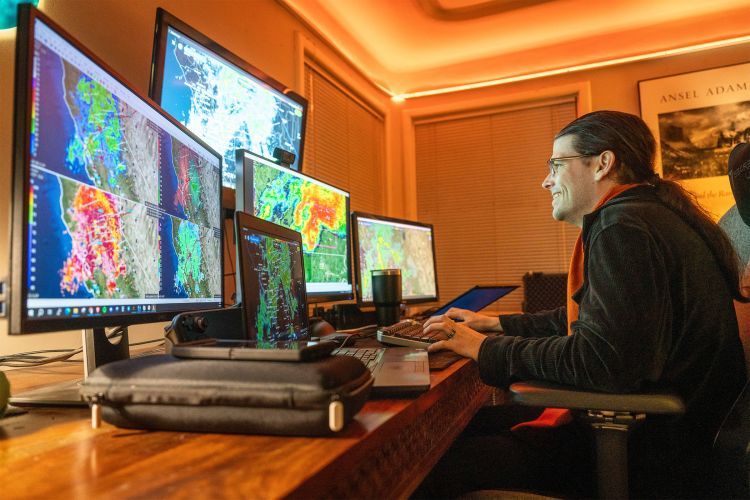Breadcrumb
Pacifican develops life-saving weather forecasting model

Shawn Kerns runs the algorithm he developed on computers from his home near the Stockton Campus.
Shawn Kerns ’10 has a fascination with weather that goes far beyond a mere hobby. He wants to save lives.
For more than a decade, Kerns has shared data and collaborated with the National Weather Service, the Discovery Channel and other agencies to help predict tornadoes and other dangerous weather conditions throughout the United States.
Computers in Kern’s home, just three blocks from campus, run the algorithm he developed to provide early notifications that can arrive 30 minutes to an hour before a storm’s apex, compared to more typical warnings of 10 minutes.
“The challenge of giving the public advanced warning of severe weather conditions can be difficult,” said Kerns, an information security analyst at Pacific who also currently serves as chair of the Staff Advisory Council. “When you have a large-scale severe weather event, you often get distracted about where to focus. The earlier warnings allow more people to get out of harm’s way before a storm peaks.”
Kerns is putting to work his own and others’ data to make a positive difference.
“I call Shawn ‘the Renaissance man.' (He) has such a wide array of talents."
- President Christopher Callahan
Kerns’ algorithm in action
A deadly tornado in western Kentucky on Dec. 10, 2021, proved the worth and power of Kerns’ algorithm. The storm traversed 165 miles before centering on the small community of Mayfield. Its death toll was 57, but many believe it could have been worse.
Some storm forecasters had trouble pinpointing the power and scope of this twister. Working with online weather-watching colleagues, Kerns steadfastly tracked the storm from start to finish, supplying updated data.
A post-storm analysis showed how accurate—and expedient—Kerns’ algorithm had been.
“Our model predicted the areas that would be impacted and the city of Mayfield was one of them,” he said. “The National Weather Service at that point started issuing more advanced warnings, which went from five minutes all the way up to 30 minutes and longer.”
That extra time allowed people to find shelter—and quite possibly saved lives.
His weather work started at Pacific
The impetus for Kerns’ work was the movie “Twister,” a 1996 film about tornadoes. The movie propelled him to create a tornado simulation and prediction program for the Computer Simulations and Visualizations class taught by Pacific Professor of Engineering and Computer Science Jinzhu Gao.
"The field of data analytics is growing rapidly at Pacific and elsewhere, but Shawn was more than 10 years ahead of his time,” Gao said. “He was able to visualize and analyze data in a very impressive manner back when he was a student. He was so knowledgeable, and I am not surprised that he has continued to excel.”
In his Pacific graduation year of 2010, Kerns requested and received 75 years of tornado path data from agencies.
His weather expertise and yearning to learn more continued to grow from that point. During the pandemic, when he had more time to follow weather events and patterns, he became familiar with many in the online weather-tracking community.
One such person was Reed Timmer, who became immensely popular on the Discovery Channel show Storm Chasers.
“He was frequently out live storm chasing and I communicated with him via online chat using Facebook, YouTube, and Twitter (now called X) during storms,” Kerns said. “I would tell him ‘Hey, this storm looks like it’s going to produce something serious,’ and we would monitor the movement—Reed from on site with the storm and myself from California.”
Kerns calls Timmer a “truly inspirational person to me and a leader in the weather field who encourages everyone to ‘Never Stop Chasing.’”
Pacific leadership proud of Kerns’ achievements
Kerns’ influence will become more widespread. He plans to “open source” the code for his algorithm and release it to the public in mid-March of 2024. Others will be able to use the application or incorporate the code into existing models to improve their accuracy.
“I hope agencies adopt my model to support their existing warning techniques and systems. I feel the more eyes on these weather events, the better,” he said.
President Christopher Callahan views Kerns as a special Pacifican whose quest for learning never wanes.
“I call Shawn ‘the Renaissance man,’” said Callahan, who meets regularly with Kerns in his Staff Advisory Council leadership role. “Shawn has such a wide array of talents—from his Information Technology prowess, to leading our campus Toastmasters (public speaking) chapter, to teaching classes, to creating an algorithm to help the National Weather Service. He even designed our pickleball rackets.
“But most importantly, Shawn is a supremely positive and forward-looking thinker and doer. In his leadership of SAC and with everything he does, he is an outstanding leader and role model for all of us,” the President said.
Mo Balakrishnan, director of information security operations and Kerns’ supervisor at Pacific, marvels at his capacity to manage multiple high-level tasks.
“Shawn is exactly the type of employee we want here at Pacific,” Balakrishnan said. “He believes in the university’s mission. I cannot sing his praises any louder.”





